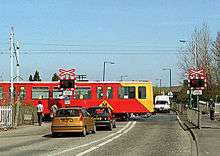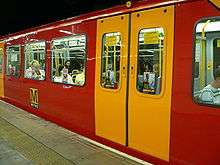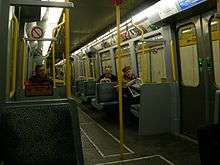Tyne and Wear Metro rolling stock
| Tyne & Wear Metrocar (British Rail Class 994) | |
|---|---|
.jpg) Tyne and Wear Metro train 4029 at South Shields | |
.jpg) Interior of Tyne & Wear Metrocar | |
| In service | 1980 - present (to be withdrawn by 2024) |
| Manufacturer | Metro-Cammell |
| Built at | Washwood Heath, Birmingham |
| Constructed | 1975, 1978-81 |
| Entered service | 1980 |
| Refurbishment | Jun 2010 - Jul 2015 |
| Number built | 90 units |
| Number in service | 89 units |
| Formation | 2 units per train |
| Fleet numbers |
994001 - 994090 (TOPS) 4001 - 4090 (TWM) |
| Capacity | 64 seats, 188 standing |
| Operator(s) | Tyne and Wear Metro |
| Depot(s) | Gosforth depot |
| Line(s) served | Green, Yellow |
| Specifications | |
| Car body construction | Aluminum and steel |
| Car length | 4.3 SLU 27.8 m (91 ft) |
| Width | 2650 mm |
| Height | 3445 mm |
| Doors | 2 sets of double doors per car, at 1/3 and 2/3 |
| Maximum speed | 50 mph (80 km/h) |
| Weight | 39 metric tonnes |
| Power output | 700 HP per unit |
| Electric system(s) | 1,500 V DC Overhead lines |
| Current collection method |
Pantograph Type: Brecknell Willis high reach |
| Multiple working | Units operate in pairs. Single units are very rare and are usually a result of a unit failure. Unused passenger capability for 3 cars. 3 and 4 car formations are for empty stock movements only. |
| Track gauge | 4 ft 8 1⁄2 in (1,435 mm) standard gauge |
The Tyne and Wear 'Metrocar' (British Rail Class 994) serves the Tyne and Wear Metro, a light rail system in North East England, serving Newcastle upon Tyne, Gateshead, South Tyneside, North Tyneside and Sunderland. Since the inception of the Metro, the rolling stock has remained the same, however the current units are set to be replaced on a rolling basis from 2022 onwards. The 90 train fleet have been refurbished a number of times, with various liveries. Full refurbishment of the fleet took place between 2010 and 2015. Metrocars have been refurbished by Wabtec Rail at its Doncaster facility with the main goal of the project to extend their service life until 2025.[1]
Design


The design of the Metrocars was partly derived from that of the German Stadtbahnwagen B, although the Metrocars were built by the now-defunct Metro-Cammell in Birmingham (now part of Alstom) and were not fitted with the lights and indicators that would have allowed them to run on city streets. Prior to opening, the Metro's two prototypes, 4001 and 4002, still in service, underwent several years of testing at the Metro's test track on North Tyneside, opened in 1975.
Each unit consist of two permanently connected halves mounted on three bogies. The outermost bogies are powered, with the centre bogie being articulated between both halves. The trains make use of rheostatic braking, with air-operated disc brakes for use during the final stages of deceleration below 30kph. All bogies are also equipped with a pair of emergency magnetic track-brakes, which can be used to bring a train to a complete stand in as little as 150m from the maximum service speed.
The prototype cars were very similar to the production fleet with the exception of their Kiekert passenger doors, which were refitted to match the specification of the production fleet before entering revenue service. The prototype cars were also fitted with two different types of block coupling equipment (one at each end), allowing the two designs to be thoroughly tested. Prior to their entry into service, the two prototypes were converted to reflect the specification of the production fleet.
The track was also used to test cars for the Hong Kong MTR, also built by Metro-Cammell. To accommodate the larger Hong Kong cars a short above-ground test tunnel had to be demolished. The test track was built on the route of an old mineral wagonway, and it is now home to the Stephenson Railway Museum.
Including the two prototype trains, a total of 90 two-car sets were constructed (the original specification for the system stated 120 trains, but this number was cut back due to funding problems). All but one of the units are in active service today, the sole exception being unit 4022, which was involved in a derailment at Gosforth depot and sustained significant damage.[2] It was sent to Bristol and is now being repaired by Wabtec Corporation.[3]
The units are allocated TOPS numbers 994001-90, for use when working on the section between Pelaw Junction and Sunderland, which is owned and operated by Network Rail. They also have different horn sounds, as they have been updated on some Metrocars throughout the years of their life.

Livery


The Metro fleet was initially painted in a two-tone livery of cadmium yellow and white that matched the Metro station design and the livery of the Tyne and Wear bus fleet until 1986. In the mid-1990s, a new colour scheme was introduced - solid red, green, or blue with a yellow wedge at each end and yellow triangles on the doors. This scheme was modified slightly in 2005, in part to comply with safety regulations - the doors were changed to solid yellow to comply with the Disability Discrimination Act. In addition to the standard colour scheme, a large number of special liveries existed. These were often advertisements for local businesses such as Metrocar 4042 advertising the Evening Chronicle. To celebrate the Queen's Golden Jubilee in 2002, unit 4032 was temporarily decorated in a special gold livery. It was then returned to the red and yellow livery, which it carried until refurbishment.
Between 2011 and late 2015 the Metrocars have undergone a refurbishment, the refurbished metrocars carry a black and yellow livery. 86 of the 90 units were refurbished, whilst 4 units (4001, 4002, 4040 and 4083) were not refurbished. The refurbishment reduced the number of liveries in use. All of the refurbished metrocars carry the same black and yellow livery. Metrocars 4033 and 4082 carried a promotional livery for Emirates (airline). however as of August 2018 they have been repainted to match the other units.[4] Metrocars 4040 and 4083 (not refurbished) continue to carry an Emirates livery. Until 2017, prototype unit 4001 carried its original cadmium-and-white livery whilst 4002 carried an advertisement for the Tyne and Wear Metro Website. Both were repainted in 2017 into the same black and yellow livery carried by the refurbished Metrocars. As a consequence of this, the only liveries that currently exist are the standard black and yellow and the Emirates promotional livery that is seen on 4040 and 4083.
Electrics

The network is electrified with a 1,500 V overhead line system using DC current. This voltage was previously used on the Woodhead Line but is now unique in Britain. Each two car Metro set has its own pantograph for collecting power.
Metro has a maximum speed of 80 km/h (50 mph), which it attains on rural stretches of line. The vehicles have a minimum curve radius of 50 m (55 yd), although there are no curves this tight except for the non-passenger chord between Manors and West Jesmond.
Service formations

During the early years of Metro, units were operated in single and double sets.
As single units became overcrowded, Nexus resumed using two units as standard.[5] Single units again became common during construction of the Sunderland extension when some units were taken for testing of the new track. During original construction, the Metro system was designed to use three unit sets, and some platforms were constructed to accommodate this, however due to a lack of funding this was not possible. As a result, the units run in sets of two. In the future Nexus was quoted as saying platforms could be extended to accommodate three units.
Announcements

The "stand clear of the doors please" announcement, which sounded before the doors started to close, was introduced in 1991. In order to increase the clarity of the announcement (especially for individuals not fluent in English) the phrase was replaced with "doors closing" in 2004.
In 2011, the "doors closing" recording was replaced in post-refurbishment Metrocars with a simple beeping sound, similar to that of the London Underground. The train emits a solid 3-second beep when the doors are released, and a rapid 3-second beeping immediately before the doors are closed, in line with the 2010 UK Rail Vehicle Accessibility Regulations (RVAR).
When the automated next station announcements were introduced they featured a female announcer, however during late 2014 this was replaced with a male announcer.
Future
Nexus has invested £1.7 million on audio visual display boards on-board its 90 strong fleet of trains to provide station information. Full refurbishment of 86 cars in the fleet has taken place at Wabtec Rail in Doncaster. This commenced June 2010 and was completed in July 2015,[6] extending their life until 2025 when they will have been replaced by a new fleet. The old fleet will be over 40 years old by this point, even though the original design life of the trains was only 30 years.
The refit at Wabtec saw the trains undergo corrosion correction work, to repair damage as a result of the trains' steel and aluminium construction, new seating, flooring and interior finish, in addition to improved saloon and emergency lighting. A new larger wheelchair space has also been created at the end of each car, featuring a "call for assistance" device. Other minor modifications include improved door seals, more concise interior signage and removal of the green boarding lamps to facilitate new audio warning equipment for door operation. Some Metrocars also featured air conditioning boxes at their A end to control the conditions within the drivers cab, these were later removed from the units due to OHLE clearance issues if trains were to be placed on wheelskates. Passenger counters were integrated above doors to help Nexus analyse trends in passenger levels. These features were removed from the specification midway through the refurbishment however.
Due to budget constraints as a result of the trains being in worse condition than anticipated, a total of 4 sets were not refitted. These will include the converted prototype trains, 4001 and 4002, in addition to 4040 and 4083 from the production fleet. These 4 units, which equate to 2 consists in passenger service formation, are electrically incompatible with the wider fleet for use in revenue service. Nexus has stated that the units which are not refitted will be held in reserve, only seeing use during periods of high demand, for example extra services during the Christmas period or for local sporting fixtures.
Proposed new fleet
Nexus have made replacing the ageing fleet of trains, which have been in constant service since 1980, a priority. Due to the advancing age of the fleet, reliability problems have become increasingly common, resulting in breakdowns and cancellations of services. Nexus have stated, that unless a new fleet of trains is available by the end of 2021, swingeing cuts will have to be made to peak time services.[7] In 2016 plans were unveiled to secure funding for a new £550 million replacement fleet, with a target for them to be in service by the early 2020s.[8]
In November 2017, the Chancellor Philip Hammond announced that the government would provide £337 million - just over 60% of Nexus' original target - towards the new fleet.[9] The proposed new fleet would consist of 84 trains to replace the existing 90 train fleet, as Nexus believe that the improved reliability of the newer trains would allow them to operate the same service levels with fewer trains. These are proposed to have longitudinal seating similar to that seen on the London Underground, instead of the current 2+2 bench seating arrangement and would feature a full width driving cab instead of the small driving booth of the existing trains.[7] The proposed new fleet is planned to have dual voltage capability, making it able to operate on the Metro's existing 1.5 kV DC electrification system as well as the 25 kV AC used on the national rail network, to allow for potentially greater service flexibility and possible future electrification of the Durham Coast Line. Battery technology is also being considered.[10][11][7]
On 17 September 2018, Nexus announced that five companies had been selected to bid for the contract to produce the new fleet. The shortlisted bidders are Bombardier Transportation, CAF, Hitachi, Stadler Rail and a consortium of Australian company Downer EDI Rail and China's CRRC Changchun Railway Vehicles. [12] CAF are offering their Civity platform in their proposal for the fleet. Nexus aim to select a preferred bidder by the end of 2018.
Ancillary vehicles
In addition to its passenger trains, the Tyne and Wear Metro also owns and operates three battery-electric locomotives, constructed by Hunslet in 1988 and numbered BL1, BL2 & BL3, as well as a Plasser & Theurer 08-275 NX ballast tamper and 15 wagons.[13]
References
- ↑ "Company chosen to refurbish Tyne and Wear's 90 Metrocars". prnewswire. Retrieved 2010-06-11.
- ↑ "Tyne & Wear Metro: Fleet Refurbishment List". RailUK Forums. Retrieved 2018-09-17.
- ↑ "Tyne & Wear Metro: Fleet Refurbishment List". RailUK Forums. Retrieved 2018-09-17.
- ↑ "Tyne & Wear Metro: Fleet Refurbishment List". RailUK Forums. Retrieved 2018-09-17.
- ↑ "May 2002 Sunderland Extension". Railway Technology. Retrieved 2007-02-20.
- ↑ "Nexus". Nexus. Retrieved 2015-09-15.
- 1 2 3 Pickering, Graeme. Metro's new fleet receives the green light (December 6–19, 2017 ed.). Rail magazine. pp. 62–67.
- ↑ "£1bn plan to improve the Metro approved by North East transport chiefs". Chronicle Live. 20 July 2016. Retrieved 24 March 2017.
- ↑ "BUDGET PROVIDES TRANSPORT BOOST FOR TYNE & WEAR". North East Times. Retrieved 3 December 2017.
- ↑ "Metro bosses unveil plans to extend network, including direct link between Sunderland and South Tyneside". Sunderland Echo. Retrieved 18 March 2017.
- ↑ "New trains and expanded network put forward in Tyne and Wear Metro strategy". Global Rail News. Retrieved 18 March 2017.
- ↑ "Shortlisted bidders revealed for £360m Tyne and Wear rolling stock deal". www.railtechnologymagazine.com. Retrieved 2018-09-17.
- ↑ "TheTrams.co.uk: Tyne and Wear Metro—2005 depot open day". www.thetrams.co.uk. Retrieved 19 July 2016.
External links
| Wikimedia Commons has media related to Tyne and Wear Metro trains. |